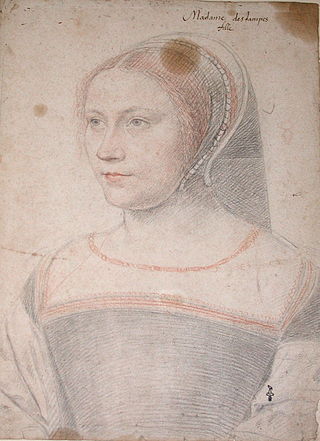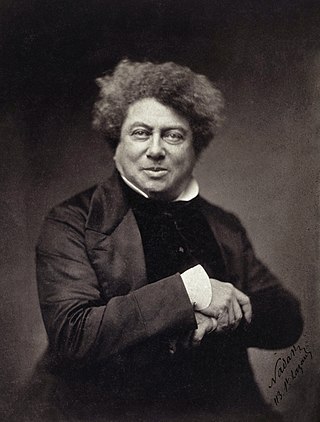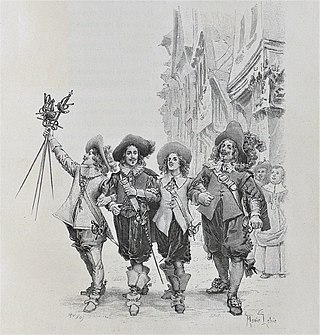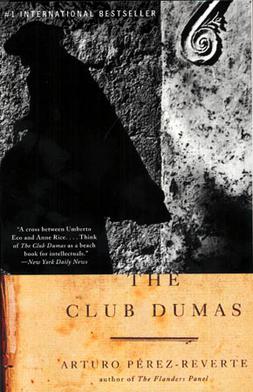Related Research Articles

The Count of Monte Cristo is an adventure novel written by French author Alexandre Dumas (père) completed in 1844. It is one of the author's most popular works, along with The Three Musketeers. Like many of his novels, it was expanded from plot outlines suggested by his collaborating ghostwriter Auguste Maquet.

Diane de Poitiers was a French noblewoman and prominent courtier. She wielded much power and influence as King Henry II's royal mistress and adviser until his death. Her position increased her wealth and family's status. She was a major patron of French Renaissance architecture.

The Château de Montsoreau is a Flamboyant Gothic castle in the Loire Valley, directly built in the Loire riverbed. It is located in the small market town of Montsoreau, in the Maine-et-Loire département of France, close to Saumur, Chinon, Fontevraud-l'Abbaye and Candes-Saint-Martin. The Château de Montsoreau is situated at the confluence of two rivers, the Loire and the Vienne, and the meeting point of three historical regions: Anjou, Poitou, and Touraine. It is the only château of the Loire Valley built directly in the Loire riverbed.

Alexandre Dumas fils was a French author and playwright, best known for the romantic novel La Dame aux Camélias, published in 1848, which was adapted into Giuseppe Verdi's 1853 opera La traviata, as well as numerous stage and film productions, usually titled Camille in English-language versions.

Alexandre Dumas, also known as Alexandre Dumas père, was a French writer. His works have been translated into many languages and he is one of the most widely read French authors. Many of his historical novels of adventure were originally published as serials, including The Count of Monte Cristo, The Three Musketeers, Twenty Years After and The Vicomte of Bragelonne: Ten Years Later. His novels have been adapted since the early twentieth century into nearly 200 films.

The Three Musketeers is a French historical adventure novel written in 1844 by French author Alexandre Dumas. It is in the swashbuckler genre, which has heroic, chivalrous swordsmen who fight for justice.
The d'Artagnan Romances are a set of three novels by Alexandre Dumas (1802–1870), telling the story of the 17th-century musketeer d'Artagnan.
La Dame aux Camélias is a novel by Alexandre Dumas fils. First published in 1848 and subsequently adapted by Dumas for the stage, the play premiered at the Théâtre du Vaudeville in Paris, France, on February 2, 1852. It was an instant success. Shortly thereafter, Italian composer Giuseppe Verdi set about putting the story to music in the 1853 opera La traviata, with female protagonist Marguerite Gautier renamed Violetta Valéry.
The Knight of Sainte-Hermine is an unfinished historical novel by Alexandre Dumas, believed to be Dumas' last major work. The novel was lost until the late twentieth century. Dumas scholar Claude Schopp found an almost-complete copy in the form of a newspaper serial. A number of Dumas' previously forgotten works have been found, but this novel is the largest and most complete at 900 pages.
Cherchez la femme is a French phrase which literally means 'look for the woman'. It is a cliche in detective fiction, used to suggest that a mystery can be resolved by identifying a femme fatale or female love interest.

The Club Dumas is a 1993 novel by Arturo Pérez-Reverte. The book is set in a world of antiquarian booksellers, echoing his previous 1990 work, The Flanders Panel.

The Mysteries of Paris is a novel by the French writer Eugène Sue. It was published serially in 90 parts in Journal des débats from 19 June 1842 until 15 October 1843, making it one of the first serial novels published in France. It was an instant success and singlehandedly increased the circulation of Journal des débats. It founded the "city mysteries" genre, spawning many imitations.

Le Cousin Pons is one of the last of the 94 novels and short stories that make up Honoré de Balzac’s Comédie humaine. Begun in 1846 as a novella, it was envisaged as one part of a diptych, Les Parents pauvres, along with La Cousine Bette. The book was originally published as a serial in Le Constitutionnel, but during 1847 it grew into a full-length novel, with a male poor relation, Pons, as its subject,

Auguste Maquet was a French author, best known as the chief collaborator of French novelist Alexandre Dumas, père, co-writing such works as The Count of Monte Cristo and The Three Musketeers.

Ascanio is a grand opera in five acts and seven tableaux by composer Camille Saint-Saëns. The opera's French libretto, by Louis Gallet, is based on the 1852 play Benvenuto Cellini by French playwright Paul Meurice which was in turn based on the 1843 historical novel by Alexandre Dumas, père. The name was changed to Ascanio to avoid confusion with the Berlioz opera Benvenuto Cellini. The opera premiered on March 21, 1890, at the Académie Nationale de Musique in Paris, in costumes designed by Charles Bianchini and sets by Jean-Baptiste Lavastre and Eugène Carpezat, Auguste Alfred Rubé and Philippe Chaperon and Marcel Jambon.

Paul Meurice was a French novelist and playwright best known for his friendship with Victor Hugo.
The Conspirators is a novel written by Alexandre Dumas and Auguste Maquet, published in 1843. Dumas reworked a preliminary version by Maquet; this was the beginning of their collaboration which was to produce eighteen novels and many plays. The dramatisation of the novel – in five acts, a prologue and ten tableaux – was first performed on 16 July 1849 at the Théâtre-Historique in Paris. It was adapted into an opera, Le chevalier d'Harmental, by André Messager with a libretto by Paul Ferrier, which was first performed on 5 May 1896.

The Théâtre Historique, a former Parisian theatre located on the boulevard du Temple, was built in 1846 for the French novelist and dramatist Alexandre Dumas. Plays adapted by Dumas from his historical novels were mostly performed, and, although the theatre survived the 1848 Revolution, it suffered increasing financial difficulty and closed at the end of 1850. In September 1851 the building was taken over by the Opéra National and renamed again in 1852 to Théâtre Lyrique. In 1863, during Haussmann's renovation of Paris, it was demolished to make way for the Place de la République. The name Théâtre Historique was revived by some other companies in the late 1870s and early 1890s.

Charles Jean-Baptiste Jacquot, who wrote under the pen name Eugène de Mirecourt, was a French writer and journalist. The main critic of Alexandre Dumas, he contributed novels, short stories and biographies to the French literary life of the second half of the 19th century.
Henry III and His Court is a play written by Alexandre Dumas (père), based on the life of Henry III of France. It was the author's first produced play. Its premier performance at the Comédie-Française on 10 February 1829 was attended by the Duke of Orléans, the future king Louis Philippe I. The play was met with great acclaim and is considered an important work in the development of romanticism in French theatre.
References
- ↑ Hemmings, F. W. J. (2011). Alexandre Dumas: The King of Romance. A&C Black. pp. 130–1. ISBN 9781448204830.
- ↑ Meurice, Paul (1865). Les deux Diane: drame en cinq actes et huit tableaux (in French). Librairie Internationale. pp. ii.
- ↑ Munro, Douglas (1978). Alexandre Dumas Père: a bibliography of works translated into English to 1910 . Garland Pub. pp. 121. ISBN 9780824098360.
- ↑ Dumas, Alexandre; Sigaux, Gilbert (1978). Œuvres d'Alexandre Dumas: Les deux Diane (in French). Club de l'honnête homme. p. xii.
- ↑ The Dumasian. 1956.
- ↑ Bell, A. Craig (1950). Alexandre Dumas: A Biography and Study. Cassell. p. 398.